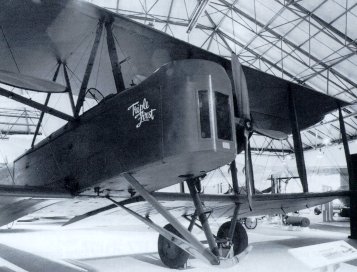Pic Right: Replica of the Alcock and Brown Vimy on display at the RAF Museum, Hendon
Alan Green looks at the 80th anniversary of the first Transatlantic flight…
If you've already planned your summer vacation, chances
are the arrangements were made with comparative ease and the journey is
likely to be smooth and trouble free.
Yet 80 years ago this month, the first
direct non-stop Transatlantic air crossing was anything but smooth or
easy. During 14 / 15 June 1919, Capt. John Alcock (pilot) and Arthur

MILESTONES IN AIR TRAVEL - JUNE 14th 1919
Monetary Incentive
The Daily Mail’s Lord Northcliffe, a visionary regarding air travel,
had put up a £10,000 prize for the premier aviators to cross the Atlantic
non-stop. Several teams entered the race but were unsuccessful. With
superb flying skill, navigation of the highest order and total dedication,
Alcock and Brown rose to the challenge despite appalling weather and
extreme difficulties.
At their St. Johns base, the Vimy was rebuilt and prepared for flight. News of the earlier failures by their rivals raised the men’s spirits, but high winds and driving rain forewarned them of what was to come..
The Adventure Begins
With final pre-flight testing completed, 300 air mail letters
As they climbed to avoid the worst of the weather, so ice became a major problem covering the Vimy's flying surfaces and threatening to force them down. Brown, despite a lame leg, had to crawl out along the wings in the full force of the slipstream to hack away at the mass. Throughout their entire adventure, Alcock, the pilot, ate with one hand while keeping the other on the control column and both feet firmly on the rudder bar!
Soon, more was to go wrong. Firstly, a small electric generator failed leaving the men without any means of radio communication, unable to send even an SOS. Later, part of the starboard engine exhaust pipe broke away allowing fumes to drift across the cockpit and causing a deafening roar for the remainder of the flight.
At one point, the Vimy spiralled out of control, plummeting from 4,000 feet and breaking through the clouds - just barely above sea level! With lightning-like reflexes Alcock regained his sense of balance -and righted the aircraft to the horizon. But as Brown checked his compass, he realised something was amiss. They were
Mission Accomplished
Eventually, after nearly 17 hours in the air, land was sighted and
Alcock looked for somewhere safe to put down. At 08.48 GMT on Sunday 15
June 1919, the aircraft touched terra-firma but its' wheels sunk into the
ground. They'd landed rather unceremoniously in a bog! The airplane
nosedived into the mire, throwing the men forward.
Then on December 8th that same year, Alcock was killed in a flying accident. Brown mourned the loss of his friend for the rest of his own life (he died in 1948) and never flew again.
Interestingly, on display at the RAF Museum, Hendon, is a McDonnell Phantom FGR2 which reprised the flight in June 1979 for the 60th. anniversary of that historic first crossing.
My very grateful thanks to Grp. Capt. Henry Hall RAF (Retd) and Andy Simpson, both of the RAF Museum for their help in the preparation of this article.
Next month, Call Sign looks at the conquest of the English Channel by a lone Frenchman….
© Alan Green 1999.